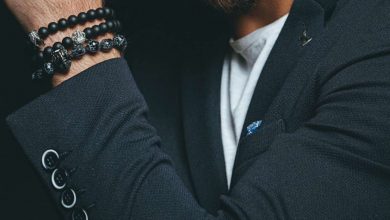How To Treat And Get Rid Of Beard Dandruff For Good

Whether you let your beard grow, keep it nearly trimmed, or keep your boundaries neat, not caring for the skin beneath your beard can be detrimental to your look. Beard dandruff, also called beard flakes or chin flakes, is the one thing that can instantly ruin even the most well-groomed beard.
The catch is that chin flakes always attack when you least expect it. You might not see it coming or even realize it exists until you get it. Fortunately, there’s no need to worry. For most men, it’s a non-permanent issue.
What Causes It?
There are three main reasons you might have beard dandruff: fungal infections, dry skin, and sensitivity to beard or skincare products.
- Fungal Infections: This type of beard dandruff, like scalp dandruff, is typically a result of seborrheic dermatitis and a type of yeast called Malassezia. Essentially, the yeast can trigger your body to produce more oil, leading to skin inflammation and flaking.
- Dry Skin: Dry skin can be caused by environmental factors that dehydrate the skin like excessively warm or cold weather. It can also result from cleansing products that strip your skin of its natural oils. In both cases, your skin can become dehydrated and start flaking.
- Product Sensitivity: If your skin is sensitive to an ingredient in a product used on your beard, you may experience dry, inflamed, irritated, or flaking skin.
Beard dandruff is easily treated or prevented by incorporating some light beard care steps in your day.
The Products You Need
Part of maintaining a beard—and a requirement to keep it dandruff-free—is taking proper care of the skin underneath. Using the right products and tools will make doing so noticeably easier. Here’s what you need, at a minimum:
- Beard Balm, Oil, Moisturizer, or Butter
Regardless of what caused it, dry and flaking skin is the main culprit behind beard flakes. Keeping your beard and the skin below hydrated prevents and treats dry skin as well as beard dandruff by extension.
The type of hydrating product you use comes down to the type of beard you have and your personal preference. You can get moisturizers, balms, oils, butter, and other products. If it’s your first time using beard care products, you’re encouraged to try several and find what you like. Look for online stores that sell various beard care products and trial packs on their page.
If you have a short beard, you might consider a beard balm or beard butter. These have some degree of hold to them and will help when brushing your beard. Beard oils are often too liquid for men with short beards and are best used sparingly because too much excess oil can result in pimples.
Beard oil is generally preferred by men with long beards. It’s easier to spread and brush through, adds a good smell, keeps your beard looking healthy, and helps condition it against the environment.
- Shampoo
Head shampoos are often too harsh for the beard and will strip away too much of your skin’s natural oils. But you still need shampoo to wash away existing dandruff, old beard products, and anything else that may get stuck in a beard.
Specifically, look for beard shampoos. These sometimes come as a ‘beard and face’ combo and are often found in the same places you can get your other beard care products.
- Beard Brush
Beard brushes are an absolute game-changer when it comes to tackling dandruff and beard care in general. Try to get a boar hair beard brush if you can, although a nylon brush will work if you can’t or don’t want to.
Beard brushes—especially boar hair ones—are excellent at spreading the oils and products you use through your beard. Furthermore, they tend to reach your facial skin, getting your hydrating product onto the skin and exfoliating it in one stroke. As a bonus, it feels good on your face!
- Conditioner (Optional)
Some guys like to condition their beards. It’s certainly a viable option but not always essential for short beards. If your beard is short, whichever hydrating product you use is often enough, so you don’t need a conditioner if you don’t want one. But if your beard is long, you need to treat it like long hair and regularly condition it.
Building A Routine
Finally, put it together and find a routine that works for you. It’ll take some trial and error to find the best routine for your beard, but here’s one to get you started:
- Wash your beard with shampoo once or twice a week. Not too much or you’ll dry out your beard. You can rinse it with water every day.
- Dry your beard thoroughly with a towel or a hairdryer if your beard is long enough.
- Moisturize your beard every day. Sometimes, it’s enough to use your face moisturizer on your beard. Other times, you might feel like using a balm, butter, or oil.
- Brush your beard every day.
- Trim the boundaries regularly, mainly your cheek and necklines, to keep hair—and potentially dandruff—away from where it needs to be. A quick and efficient way to clean up the lines is with a safety razor.
If you do this and still notice dandruff, you may need to experiment with other products. If you’ve tried it for a while, but dandruff doesn’t reduce or go away, consider visiting a dermatologist.
That’s It
Keeping a beard is like an ongoing journey of learning to care for it. Even when you’ve had one for years, there’s always some new issue you must learn to deal with. But beard dandruff will never be one of those things again, not for you.




